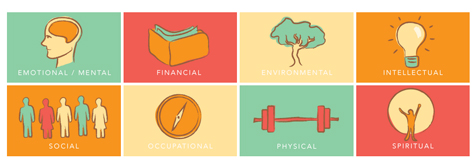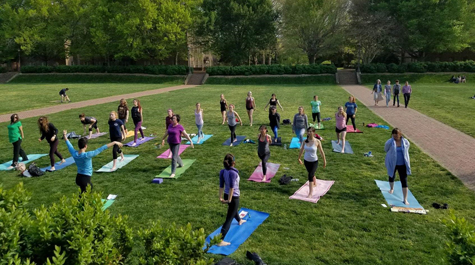Coalition creates cross-campus collaborations for a healthier W&M
W&M efforts part of national Healthy Campus 2020 initiative
While construction progresses on the McLeod Tyler Wellness Center at William & Mary, building of another kind has been underway on campus.
Faculty, staff, students and administrators have built a coalition to focus and further the university’s integrative wellness efforts as part of the national Healthy Campus 2020 initiative, and the resulting collaborations are yielding results.
The national initiative, led by the American College Health Association, is an offshoot of the Center for Disease Control’s Healthy People 2020 effort and offers “a framework for improving the overall health status on campuses nationwide,” according to the Healthy Campus 2020 website.
Participating institutions are provided with a toolkit to determine measurable goals for their respective campuses with the aim of having them reached by the year 2020.
At William & Mary, those goals fall within seven areas: health impediments to academic performance, communication, injury and violence prevention, mental health, sexually transmitted diseases, substance abuse and tobacco use.
“The great thing about it is these are national guidelines and part of a national program, but you can really customize what areas of wellness you want to focus on,” said Kelly Crace, associate vice president for health and wellness.
{{youtube:medium|wwGLuomqiw8, Eight Dimensions of Wellness}}
The W&M Healthy Campus 2020 Coalition was formed three years ago from existing committees within the Division of Student Affairs. However, in order to make it a true coalition, the group was opened to people from across campus who not only work in the areas of health and wellness but who might just have an interest and investment in the topics. Currently, the group includes representatives from campus recreation, the counseling center, the student health center, the bike alliance, kinesiology, health promotion and sustainability, among other areas.
“One of the things I love about the committee, is that it’s so diverse — there are graduates, undergraduates, there are people from all walks of campus, not just student affairs, there are also faculty involved,” said Eric Garrison, assistant director of health promotion. “It’s such a diverse and intersectional group because health is such an intersectional topic.”
Campus Recreation Wellness Supervisor Courtney Wiley '18 provides a student perspective to the group. A kinesiology and health sciences major, she finds inspiration in working with the passionate and hard-working members of the coalition as they strive to make students' health and wellness a top priority on campus, she said.
"The job of the coalition increases the quality of life of W&M students and aims to provide many outlets for students to release stress, enhance wellness and increase overall happiness, said Wiley. "The coalition is important for bridging the gap between faculty/staff members and students, recognizing that students' requests and needs are being heard and put into practice."
In addition to subcommittee meetings, the coalition meets every other week throughout the academic year in the Sadler Center, with its members enjoying lunch together while discussing work being done in their areas and ways to bring those efforts together and in line with the 2020 goals.
“We started to move the community forward on those goals — that doesn’t mean we’re always the ones doing them, but it means we connect and link different initiatives together so we make sure there’s this true coalition, true collaboration around moving our community to a healthier place,” said Crace.
One such collaboration brought a health and wellness day to the university’s Earth Week celebration for the first time this spring. Another helped make possible a research study looking at pop-up mindfulness walks. That work, led by Dorothy Ibes, a lecturer in the environmental science and policy program and director of the Parks Research Lab, was made possible through one of the mini grants offered through the coalition and helped her procure software to analyze the data she and her students collected.
Communication has been an area of focus for the coalition, and its members have worked together to increase messaging about such initiatives as the Depth Over Breadth campaign, which encourages students to focus on fewer extracurricular activities, as well as the university’s Eight Dimensions of Wellness framework, which includes emotional/mental, financial, environmental, intellectual, social, occupational, physical and spiritual health.
The coalition has created flyers, brochures, bookmarks, posters and more to promote the eight dimensions, as well as a “wellness passport” that students can use to track their efforts. Garrison has also been working with information technology to produce slides that can be posted by faculty members before classes, providing health-related tips or information about resources available on campus.

While the coalition has helped build collaborations across campus, it has also given W&M a window into issues and efforts at other universities.
“It allows us to speak the same language with other universities that are doing the same thing,” Garrison said. “It gives us a common vocabulary as other institutions, and that way, when research is done or successes are made, we can talk about what worked and what didn’t.”
At a recent, national conference on Healthy Campus 2020, Garrison discovered that other institutions — from large research universities to small community colleges — are also grappling with how to improve communication with students.
“One of the takeaways was that we can’t paint an entire generation with the same brush,” he said. “As much as this generation loves its technology, there are others who leave their phone in the car when they go on a date or don’t use Facebook or Instagram but have an identical twin brother who takes their phone everywhere and lives on Facebook or Instagram.”
In order to reach students from multiple generations at W&M, university health officials can’t just use on communication modality, Garrison said. Likewise, they can’t use a one-and-done approach to awareness and prevention efforts, which have traditionally included program-centric initiatives.
“We find that the most effective component for behavior change toward health in communities is coalition-building,” said Crace. “It is very much a part of our vision for integrative wellness, taking a relational approach to system change.”
Last year, the work of the coalition helped earn the university's Division of Student Affairs the Williamsburg Health Foundation's 2016 Williamsburg Health Foundation Award. This year, the W&M coalition is focusing on its goals related to alcohol and tobacco use as well as mental health, specifically anxiety.
"We aim to increase the number mindfulness workshops, yoga classes, educational programs, and discuss ways in which we can incorporate wellness into student's schedules without making them feel overwhelmed and overcommitted," said Wiley. "In doing so, we strive to increase faculty/staff awareness by educating them on how to exemplify positive health practices during their time spent on campus each week."
Crace invites members of the campus community who are interested in getting involved to join the coalition or just attend one of its meetings — and help expand the web of campus collaborations in order to build a healthier W&M.
“We’re constantly trying to nudge our community to see wellness as something more than just the illness-based model alone,” said Crace. “It’s about a holistic, multi-dimensional approach to seeing wellness.”
 Skip to main content
Skip to main content

